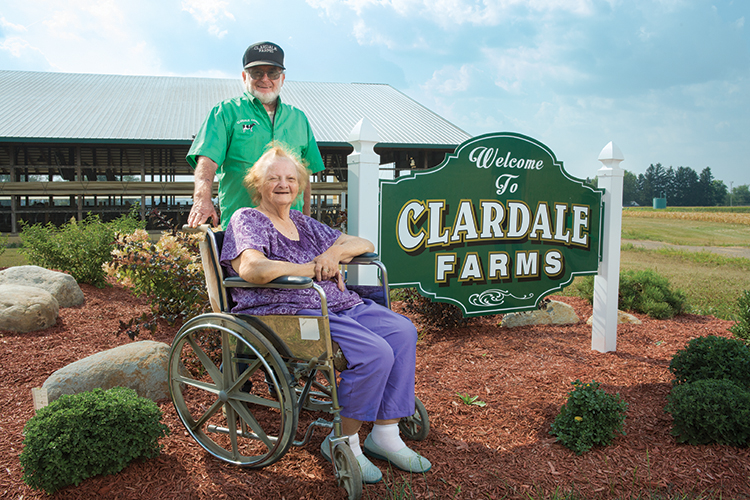Home > Ohio > Ohio Farm to Table > Dairy Farmers Are Committed to Caring
Dairy Farmers Are Committed to Caring
In partnership with: Ohio Department of Agriculture

From fresh water, feed access and cooling sprinklers to high expectations of human interaction with livestock, caring for dairy cattle is simply the right thing to do.
And to the more than 2,700 dairy farms in Ohio, such care also makes sense financially, says Scott Higgins, chief executive officer of the American Dairy Association Mideast.
“The cows produce better when they are healthy, comfortable and not afraid,” he says. “Dairy farmers have traditionally been very aware of the importance of taking great care of their animals.”
At Clardale Farms in Canal Fulton, Ohio, care permeates from the farm. A dozen relatives work on the family farm either full- or part- time. Even the farm’s namesakes, Dale and Clara Rohr, help weekly with the calves in their retirement.
Today, this fifth-generation family dairy farm operates amidst housing developments near the suburbs of Akron.
“We are close to everything,” says Frank Burkett, a fifth- generation farmer in the family. “High land prices … A prime area for building prior to the economic collapse … Traffic congestion.”
And in the middle of it are 690 milk cows that produce manure and 850 acres of crops that require slow- moving tractors and machinery.
They open their farm to neighbors, who quickly learn that the family’s respect for the environment, their milk cows and the community runs generations deep.
“We farm in a very populated area, so everything we do here, we make sure we do it as a community with our neighbors in mind,” Burkett says, adding that they invite the public to their farm regularly.

Above their milking parlor, Clardale Farms has an observation deck for public meetings, such as 4-H and Girl Scouts. This allows meeting attendants to view the milking process during their gathering.
At the farm, sand bedding keeps cows comfortable. New barns with higher sidewalls improve ventilation. Nutritionists visit weekly and make dietary adjustments based on a cow’s body condition and production. A veterinarian also visits weekly to monitor herd health.
Clardale Farms recycles its sand bedding and water. The family invested in long-term manure storage that allows flexibility with manure application. And they gladly welcome farm tours for neighbors to learn about all of it.
Three times per year, Burkett and his family apply manure on their fields. This natural fertilizer feeds the crops, which then feed their cows. In essence, manure application brings care for the environment and their animals full circle.
That aside, application does cause odor. In part, this inconvenience prompted the family’s long-term manure storage, which requires just three applications per year. The system offers the flexibility to avoid dates of nearby outdoor gatherings and community events. It also allows them to avert poor application conditions, such as rain or frozen, snowy ground.
“We want to be a zero-discharge farm,” Burkett says. “We make changes all the time to put more levels of safety in our manure storage and application system. This is where we live and work. We want to make sure to have a great environment and one that is perhaps better than when we found it when the next generation gets it.”

In addition, the family plants grass waterways to improve water quality in their fields and use no-till when applicable to reduce soil erosion. They also plant cover crops after corn harvest to protect the soil and store nutrients.
“Truth is, our dairy farmers are coaches, school board members and county commissioners,” Higgins says. “They work hard and volunteer their time and make sure their community resources are handled properly. They are very much a part of the fabric of the community they live in.”
Higgins also invites consumers to hear the stories of two dozen Ohio dairy farmers, like the Burketts, at ohioDairyFarmers.com.
“With the heightened interest of consumers wanting to know where their milk comes from, farmers are doing a better job of telling their story.”



